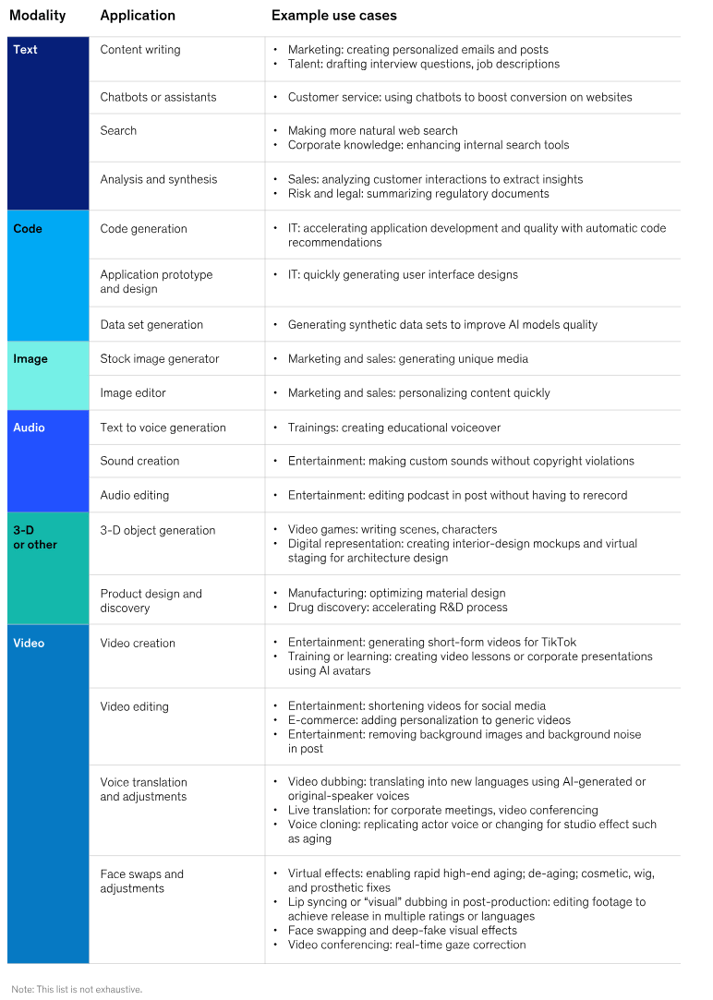Let’s ChatGPT: What does generative AI mean for real estate?

Artificial intelligence is on everyone’s minds, as large language models like ChatGPT transform the way we work. Joanna Marsh, Investa’s Head of Venture Investment & Advanced Analytics, has taken a deep dive into the world of generative AI and has some revealing insights into the implications for commercial real estate.
ChatGPT, and its more powerful successor GPT-4, have been put through their paces in 2023. Humans have discovered the power of AI to draft contracts and cut code, create instant marketing copy and clean unstructured data, compose love letters and rap lyrics, and suggest recipes from the three items sitting in the fridge.
But it is the way ChatGPT can transform the tasks of knowledge workers that keeps Joanna up at night. “Generative AI is changing the way we work forever. Anyone who uses information as the advantage will be impacted.”
What is generative AI?
Generative AI is a type of artificial intelligence that uses machine learning techniques to generate new data or content, such as images, videos or text. While traditional AI systems make decisions based on existing data, generative AI like ChatGPT analyses vast amounts of text data to identify patterns and relationships between words and phrases, and then generates new content in the form of human-like responses to text-based ‘prompts’.
ChatGPT – the GPT stands for Generative Pre-trained Transformers – is a large language model (LLM) developed by the Microsoft-backed OpenAI. GPT-4 is OpenAI’s most-advanced AI technology, and can generate eight times the text of its predecessor, ChatGPT (which is powered by GPT 3.5).
Working with generative AI comes with a lot of practical and ethical considerations. ChatGPT’s most recent data is from 2021. It can also “hallucinate” entirely inaccurate text and reinforce systemic biases.
ChatGPT has grabbed the headlines this year, but it is just one generative AI tool. OpenAI’s other recent release, DALL-E 2, generates images, as does Midjourney. And Google’s language model LaMDA, powers its search engine Bard.
Brains, bytes and bots: AI and the labour market
Researchers at Cornell University have investigated the potential implications of LLMs on the labour market, finding that around 80% of the workforce in the United States could have at least 10% of their work tasks impacted, and 19% could have 50% impacted.
"Higher-income jobs potentially face greater exposure – and these higher income jobs tend to reside in offices,” Joanna notes.
When AI passed the bar exam, the legal world was transformed overnight. Law firms are now offering financial incentives to encourage lawyers to embrace generative AI into their everyday work.
Architects are using chatbots to streamline design decisions. AI image generator DALL-E generated a “surprisingly plausible” proposal for London’s Serpentine Pavilion last year. Some pundits predict AI will accelerate architecture output fivefold.
LLMs are taking over rote administrative tasks so governments can focus on work that improves the lives of citizens. Planners and policymakers are training bots at historical data to predict future trends and on social media to monitor citizen sentiment.
In property management, lease negotiations, rent collection and maintenance scheduling are made easier with AI. In fund management, financial reporting and trend forecasting are in AI’s line of sight. Leasing agents are spending less time answering routine enquiries or writing listings and more time on high value tasks (one commercial real estate broker hailed ChatGPT as “a 24/7 personal assistant”).
Figure 1: AI applications across modalities

Source: McKinsey, Exploring opportunities in the generative AI value chain, April 2023.
AI, the “shape shifter”
Analysts at Goldman Sachs have estimated that generative AI could expose the equivalent of 300 million full-time jobs to automation. Historically, automation has created more jobs than it has destroyed, and Goldman Sachs’ notes, “the emergence of new occupations following technological innovations accounts for the vast majority of long-run employment growth”.
Another study by MIT found inequality between workers decreases as ChatGPT compresses “productivity distribution”. While the tool helps highly skilled workers, those with the lowest skill level gained the biggest productivity boost. Exposure to ChatGPT also increases job satisfaction and confidence, the study found.
It’s very early days, but academic insights so far suggest generative AI will sometimes substitute, but more often complement the existing workforce. Joanna calls it a “copilot” but agrees that “as generative AI is overlaid with other waves of transformation, such as hybrid working, it will change the way tenants use space”.
Data can help us to “see what is actually happening beyond the hype,” Joanna adds.
“It won’t necessarily mean less demand for office space. It may mean more demand, as we shift to building larger collaboration spaces for our teams. This is highly nuanced, and we need to understand our tenants’ industries and sectors, the kinds of job roles they have in each office space, and the tasks they are undertaking. Only then can we forecast future demand.”
Demand forecasting flows through to capital models, acquisition underwriting and strategic asset plans, Joanna adds. “As the kinds of roles within the workplace shifts, the design of spaces will change and so will the programming within assets.”
Contract administration is another area ripe for revolution. “The administration of construction contracts takes teams of people. But if AI can do a lot of the heavy lifting, a construction company can spend more time doing what it does best – building.” This could create more supply and place downward pressure on costs.
Change won’t be immediate, but Investa is already using ChatGPT and other generative AI tools to forecast the future.
AI copilot carries the mental load
“I look at ChatGPT as a democratic force that can eliminate some of the mental load that knowledge workers carry,” Joanna says.
At Investa, early experimentation is helping to reduce the time spent on rote tasks. Joanna has built several ‘bots’ that can identify data points, clean unstructured data and categorise contact information and write draft emails, for example.
“Often ChatGPT comes up with a witty way of phrasing a sentence or an unusual analogy that I wouldn't have used that gets me thinking in a new way.
“I'm thinking about how we translate everything back to the human. How do we make work easier for people to reduce their mental load?”
Some experiments have far-reaching implications for real estate. A lot of the data in real estate is trapped inside unstructured text, often in PDF documents such as contracts or floorplans. This is a data engineering nightmare that is becoming slightly less nightmare-ish.
Take Joanna's "tenant brief extractor", which the team developed after training GPT-4 on hundreds of de-identified tenant briefs. "We can see what tenants care about now – the grade, location, size and floorplate, and the types of facilities they want, for example. And we can watch how this may change over time." Armed with this information, Investa can augment the human intelligence of its team with real-time granular data to inform decisions about asset acquisition or retrofit, and to ensure spaces suit the unique needs of Investa’s tenant customers.
Democratisation of data
Generative AI could lead to the large-scale “democratisation of data,” Joanna adds.
LLMs are often less scary than numbers or code. Joanna recently used GPT-4 to build a complex data map to support a business strategy. With the help of human insight and ingenuity, ChatGPT wrote code which Joanna could then transfer into Github, a platform for hosting and collaborating on software development. “And after a few rounds of debugging, it worked. All of a sudden, people who don’t code can get the code they need.” Tasks that would have previously taken an “technical lift” are now achievable.
Joanna was recently appointed CEO of Exomnia, a data science start-up she co-founded. She has moved to a part-time strategic role at Investa and is focused on venture investment and AI analytics. Exomnia is developing a template-driven approach to working with data that allows everyone to ask questions, explore, customise, or simply ‘plug and play.’
“So much of valuable data is locked up in documents or spreadsheets or in people's heads. There's no Bloomberg in real estate.” While financial markets have access to a single platform of reliable data and analytics, thanks to Bloomberg, real estate data is hard to access or aggregate, even in transparent markets like Australia.
“LLMs are very good at aggregating information. All of a sudden, we can unlock these latent data assets so people can interact with them. Investment analysts can spend their time interrogating data, rather than cutting and copying,” she says.
“The way you win in real estate is to see things that other people don't see. Generative AI can help us see the signs that point to hidden ‘alpha’. And then, in a world of perfect information, humans will add the value.
“Even in a world of ever-expanding data points and rapid technology advancement - and some analysts predict more than six billion people will be using generative AI by 2028 - the greatest unfair advantage is still, as it has always been, the creativity, ingenuity and originality of our people.”


.jpg)

